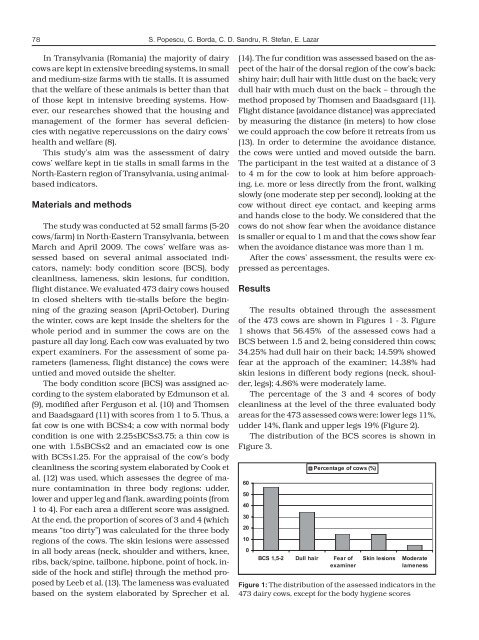SLOVENIAN VETERINARY RESEARCH
SLOVENIAN VETERINARY RESEARCH
SLOVENIAN VETERINARY RESEARCH
You also want an ePaper? Increase the reach of your titles
YUMPU automatically turns print PDFs into web optimized ePapers that Google loves.
78 S. Popescu, C. Borda, C. D. Sandru, R. Stefan, E. LazarIn Transylvania (Romania) the majority of dairycows are kept in extensive breeding systems, in smalland medium-size farms with tie stalls. It is assumedthat the welfare of these animals is better than thatof those kept in intensive breeding systems. However,our researches showed that the housing andmanagement of the former has several deficiencieswith negative repercussions on the dairy cows’health and welfare (8).This study’s aim was the assessment of dairycows’ welfare kept in tie stalls in small farms in theNorth-Eastern region of Transylvania, using animalbasedindicators.Materials and methodsThe study was conducted at 52 small farms (5-20cows/farm) in North-Eastern Transylvania, betweenMarch and April 2009. The cows’ welfare was assessedbased on several animal associated indicators,namely: body condition score (BCS), bodycleanliness, lameness, skin lesions, fur condition,flight distance. We evaluated 473 dairy cows housedin closed shelters with tie-stalls before the beginningof the grazing season (April-October). Duringthe winter, cows are kept inside the shelters for thewhole period and in summer the cows are on thepasture all day long. Each cow was evaluated by twoexpert examiners. For the assessment of some parameters(lameness, flight distance) the cows wereuntied and moved outside the shelter.The body condition score (BCS) was assigned accordingto the system elaborated by Edmunson et al.(9), modified after Ferguson et al. (10) and Thomsenand Baadsgaard (11) with scores from 1 to 5. Thus, afat cow is one with BCS≥4; a cow with normal bodycondition is one with 2.25≤BCS≤3.75; a thin cow isone with 1.5≤BCS≤2 and an emaciated cow is onewith BCS≤1.25. For the appraisal of the cow’s bodycleanliness the scoring system elaborated by Cook etal. (12) was used, which assesses the degree of manurecontamination in three body regions: udder,lower and upper leg and flank, awarding points (from1 to 4). For each area a different score was assigned.At the end, the proportion of scores of 3 and 4 (whichmeans “too dirty”) was calculated for the three bodyregions of the cows. The skin lesions were assessedin all body areas (neck, shoulder and withers, knee,ribs, back/spine, tailbone, hipbone, point of hock, insideof the hock and stifle) through the method proposedby Leeb et al. (13). The lameness was evaluatedbased on the system elaborated by Sprecher et al.(14). The fur condition was assessed based on the aspectof the hair of the dorsal region of the cow’s back:shiny hair; dull hair with little dust on the back; verydull hair with much dust on the back – through themethod proposed by Thomsen and Baadsgaard (11).Flight distance (avoidance distance) was appreciatedby measuring the distance (in meters) to how closewe could approach the cow before it retreats from us(13). In order to determine the avoidance distance,the cows were untied and moved outside the barn.The participant in the test waited at a distance of 3to 4 m for the cow to look at him before approaching,i.e. more or less directly from the front, walkingslowly (one moderate step per second), looking at thecow without direct eye contact, and keeping armsand hands close to the body. We considered that thecows do not show fear when the avoidance distanceis smaller or equal to 1 m and that the cows show fearwhen the avoidance distance was more than 1 m.After the cows’ assessment, the results were expressedas percentages.ResultsThe results obtained through the assessmentof the 473 cows are shown in Figures 1 - 3. Figure1 shows that 56.45% of the assessed cows had aBCS between 1.5 and 2, being considered thin cows;34.25% had dull hair on their back; 14.59% showedfear at the approach of the examiner; 14.38% hadskin lesions in different body regions (neck, shoulder,legs); 4.86% were moderately lame.The percentage of the 3 and 4 scores of bodycleanliness at the level of the three evaluated bodyareas for the 473 assessed cows were: lower legs 11%,udder 14%, flank and upper legs 19% (Figure 2).The distribution of the BCS scores is shown inFigure 3.Figure 1: The distribution of the assessed indicators in the473 dairy cows, except for the body hygiene scores
















